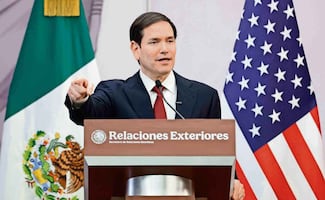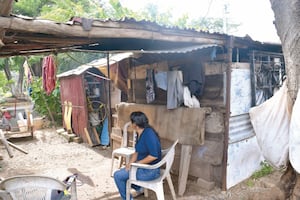Más Información
Mundial 2026 genera riesgo de fraudes y reventa, alerta Concanaco; sugiere desconfiar de enlaces y ofertas en redes sociales

Marco Rubio destaca labor de seguridad de México; "están haciendo más que nunca en su historia", afirma

Inegi oficializa creación de nueva instancia para medir la pobreza, tras desaparición del Coneval; crea una Dirección General

Juez frena revocación de testigo protegido a Raúl Rocha; da medida cautelar a dueño de Miss Universo

Sin garras y con lesiones Profepa rescata a león amarrado a un árbol en Nayarit; inician investigación
On May 18, several local governments across Mexico pushed back against President Andrés Manuel López Obrador ’s call to reopen the economy in 269 townships that do not have active cases COVID-19 cases, with leaders saying they preferred to wait until June before resuming their everyday activities.
Mexico, which has reported 54,346 total cases and 5,666 deaths, has seen a sharp climb in new infections. Moreover, front-line doctors fear that a premature reopening could lead to the second wave of infections .
However, López Obrador has been pressing to reactivate the economy. In addition to opening virus-free communities, his health advisers have said that the mining, construction, and automotive industries could resume operations this week.
The country’s lockdown, which began in March, will remain in place but those industries will be allowed to return to production because Mexico’s top advisory body on the pandemic, the General Health Council, decided to classify them as “essential activities.”
However, authorities said factories planning to reopen should implement social distancing, temperature screening, and health questionnaires rather than increase COVID-19 testing to protect employees. Mexico has performed only about 150,000 tests so far, a very low rate in comparison to other countries.
“Today productive social activity has already started to open where it was agreed, and they can start classes,” López Obrador said. “We are talking about around 300 townships where there are no infections.”
But in the majority of these communities, the President’s words did not result in any changes.
Recommended: COVID-19: The risks of reopening vulnerable communities
In Oaxaca , which has over 200 infection-free townships, Governor Alejandro Murat said officials decided to wait until June 1 to begin evaluating whether to resume economic activities . Murat also said students would not return to class on May 18 even in communities without confirmed cases of the virus.
Most of those communities are concentrated in the mountainous north of the state. Naturally isolated with few resources, they organized early against the pandemic. Many of them sealed themselves off, not only to outsiders but to their residents who happened to be away at the time. They imposed curfews , and police kept people from gathering and ensured they wore masks .
The communities protected themselves because of an early information campaign that explained COVID-19 and its dangers. The confusion started with conflicting messages from the federal government.
In Guerrero , Governor Héctor Astudillo said it remained unclear when students would return to classes.
“We are not going to return to classes on the 18th in any township, and there aren’t conditions to do it June 1 either,” he said. Guerrero had 12 townships on the federal government’s approved list, but Astudillo said that it was actually 10, because two were adjacent to communities in Oaxaca with confirmed cases.
The state’s mining and construction sectors were also preparing for resuming activities on June 1, Astudillo said.
These communities are among the poorest and marginalized in Guerrero and the country. The majority lacks public services and hospitals, making its inhabitants more vulnerable to the pandemic .
Recommended: The COVID-19 pandemic puts indigenous communities at risk
Cochoapa el Grande, Guerrero,
is the second poorest community in Mexico . According to the INEGI, 82.60% of its population lives in extreme poverty and 90.53% don’t have access to healthcare.
In Malinaltepec , 75% of homes don’t have access to running water. There aren’t enough face masks, gloves, and hand sanitizer to distribute among 58 communities; furthermore, there is not a single ventilator in Malinaltepec.
In a bid to protect themselves against the virus, inhabitants closed their roads over a month ago. People are only allowed to leave town twice a week to buy food.
A few townships that were approved to restart activities in Chiapas also decided to wait to open schools.
Jalisco
also kept schools closed in its approved communities but allowed work to resume in some sectors.
Governor Enrique Alfaro
, who has publicly disagreed with some moves by federal health officials, announced that some “non-essential” businesses that do not generate crowds, as well as services like plumbing and landscaping and beauty salons would be allowed to reopen.
“Here there are no townships that open and others that don’t,” Alfaro said, noting that the issue should not be for a Mexico City bureaucrat to decide. “It’s a serious mistake this idea of opening some townships and not others. That decision isn’t going to happen in Jalisco, nor be followed.”
Chihuahua
said none of its townships on the federal government’s list would reopen because they were close to Ciudad Juárez . Governor Javier Corral cited the tight relationship with El Paso, Texas, and the cross-border activity it entails in saying that none towns on the list would reopen yet.
Recommended: Vulnerability index reveals millions are at risk of contracting COVID-19 if 269 communities resume their activities
gm
Noticias según tus intereses
[Publicidad]
[Publicidad]









